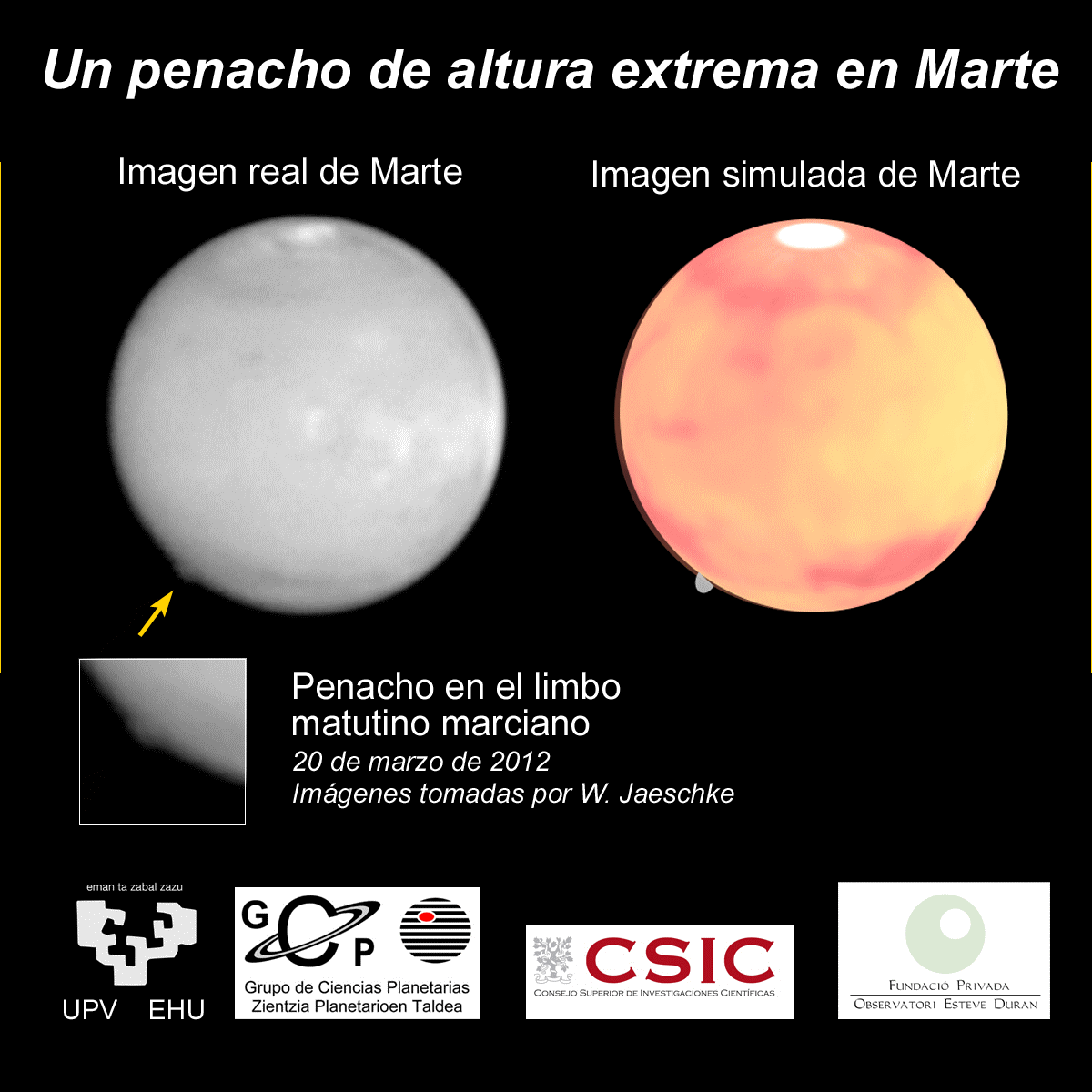The highest plume ever observed on Mars
Researchers are studying images of a mysterious bulge that rose up more than 200 km from the surface
In March 2012 amateur astronomers in different corners of the world gathered images of a plume emerging at dawn on the edge of the disc of Mars. Even though spacecraft orbiting Mars have on numerous occasions observed thin cloud layers on the limb, the maximum altitude of these layers has never exceeded 100 km. This bulge, by contrast, was over 200 km high and could be seen over about ten days, but only during the Martian dawn. So far, with current knowledge about the high atmosphere of Mars, it is not possible to account for this phenomenon, which could pose a hazard for future low-orbit missions to Mars. The research has been released in advance of publication on 20 February in the journal Nature.

In the thin, cold, dry atmosphere of Mars the winds blow and raise the dust from the surface to an altitude of about 50 km. In its core thin clouds of ice and carbon dioxide crystallites are formed; they are the main component of the Martian atmosphere which on occasions can reach, at the most, altitudes of about 100 km. Spacecraft orbiting Mars have taken photos of the suspended dust and the high clouds above the planet's limb or edge projected against the black background of the sky.
In March and April 2012 amateur astronomers across the world equipped with their high-resolution telescopes and cameras took advantage of Mars moving closer to the Earth to get detailed images of the planet. They got a surprise when they spotted the presence of a high plume on the edge of the disc emerging on the limb during the Martian dawn. The bulge was observed rotating with the planet above the limb for about ten days in March, which unequivocally confirmed its presence. Strangely enough, after various days without being spotted, it was possible to see it once again for several days in April.
By analysing a selection of the best images, the team have measured this plume that appeared in the Martian region of Terra Cimmeria at one of the middle latitudes of the Southern hemisphere and have developed a geometrical model to account for its visibility. The researchers have confirmed that the plume, which extends horizontally about 500 km, reached an exceptional altitude on March 20 and 21 of between 200 and 250 km above the surface of Mars. Never before had a phenomenon that reached such a height on the planet been observed. The research team also managed to determine its brightness on different wavelengths.
In parallel, when looking in the archive of images taken by the Hubble Space Telescope they came across images dating back to May 1997 in which it is possible to see the presence of a plume similar to the one studied at equatorial latitudes. In this case, they did not manage to determine its altitude exactly, but they were able to measure its reflectivity in more detail, which has helped them delve further into the nature of the phenomenon.
Armed with these data, "we have explored two possible scenarios to interpret the phenomenon: it could be a cloud or an auroral emission," said Prof Agustín Sanchez-Lavega (UPV/EHU), leader of the research. In other words, it could either be an unusual cloud which, consistent with its brightness, could comprise crystallites of 0.1 microns in size (one ten-thousandth of a millimetre). However, for water crystallites to be able to form at an altitude of 200 km, the temperature would need to fall more than 50 degrees (100 degrees if they were of carbon dioxide) with respect to what is predicted by the current models of Mars. Another possibility is that the plume could be produced by a light emission of an aurora type, as in the Cimmeria region there is an intense magnetic anomaly that could channel charged particles coming from outside and excite the emission. However, that would imply an emission about 1,000 times more powerful than that of terrestrial auroras, which is not feasible. "Both hypotheses, even if they are the most plausible ones, seem impossible insofar as they challenge our current knowledge about the Martian atmosphere," said Sánchez-Lavega.
Given the risk that the presence of these unpredictable high plumes could pose in future low-orbit or planetary entry missions, the search and study of them will continue with observations from Earth and from orbiting spacecraft.
A. Sánchez-Lavega, A. García Muñoz, E. García-Melendo, S. Pérez-Hoyos, J. M. Gómez-Forrellad, C. Pellier5, M. Delcroix5, MA. López-Valverde, F. González-Galindo , W. Jaeschke, D. Parker, J. Phillips, y D. Peach. An extremely high - altitude plume seen at Mars. Nature. DOI: 10.1038/nature14162
Instituto de Astrofísica de Andalucía (IAA-CSIC)
Unidad de Divulgación y Comunicación
Silbia López de Lacalle - sll[arroba]iaa.es - 958230532
http://www.iaa.es
http://divulgacion.iaa.es

